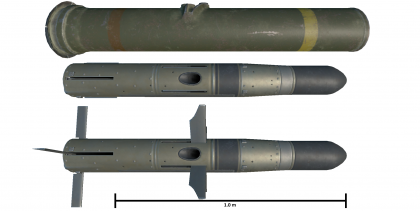BGM-71 TOW
Contents
Description
Write an introduction to the article in 2-3 small paragraphs. Briefly tell us about the history of the development and combat using the weaponry and also about its features. Compile a list of air, ground, or naval vehicles that feature this weapon system in the game.
Vehicles equipped with this weapon
General info
Tell us about the tactical and technical characteristics of the missile.
Effective damage
Describe the type of damage produced by this type of missile (high explosive, splash damage, etc)
| Penetration statistics | |||
|---|---|---|---|
| Penetration (mm) @ Angle of Attack (°) | |||
| 0 | 30 | 90 | |
| BGM-71A TOW | 430 | 372 | 215 |
| BGM-71C I-TOW | 630 | 546 | 315 |
| BGM-71D TOW-2 | 800 | 693 | 400 |
Comparison with analogues
Give a comparative description of missiles that have firepower equal to this weapon.
Usage in battles
Describe situations when you would utilise this missile in-game (vehicle, pillbox, base, etc)
Pros and cons
Summarise and briefly evaluate the weaponry in terms of its characteristics and combat effectiveness. Mark pros and cons as a list.
Pros:
Cons:
History
Examine the history of the creation and combat usage of the weapon in more detail than in the introduction. If the historical reference turns out to be too long, take it to a separate article, taking a link to the article about the weapon and adding a block "/History" (example: https://wiki.warthunder.com/(Weapon-name)/History) and add a link to it here using the main template. Be sure to reference text and sources by using <ref></ref>, as well as adding them at the end of the article with <references />.
HAW
Fall of 1958, the Army's Office of Ordnance Research and Development formed the Ad Hoc Working Group at the Ballistic Research Laboratories (BRL) to define a future replacement for the SS.10 and 11. The team included members from Picatinny Arsenal, Frankford Arsenal, Redstone Arsenal, Watervliet Arsenal, Detroit Arsenal and Harry Diamond Laboratories.
Manual guidance systems (MCLOS) of earlier weapons like SS.11 were found to be difficult to use as the relative movements of the launcher and target increased; MCLOS worked well for stationary launchers and slow-moving targets, but had proven much more difficult to use from moving vehicles, especially helicopters.
Experience and issues with the MGM-51 Shillelagh missile especially the infrared link proved relatively unreliable in the field and was subject to countermeasures like random flashing IR lamps. For the shorter ranges envisioned for HAW, wire-guidance was perfectly suitable and both much less expensive and largely immune to countermeasures.
The resulting design was tube-launched, optically tracked, and wire-guided. BRL programmer Harry Reed immediately christened it "TOW" (Tube-launched, Optically tracked, Wire-guided), a name that the system carried into production.
Media
Excellent additions to the article would be video guides, screenshots from the game, and photos.
See also
Links to the articles on the War Thunder Wiki that you think will be useful for the reader, for example:
- reference to the article about the variant of the weapon;
- references to approximate analogues by other nations and research trees.
External links
Paste links to sources and external resources, such as:
- topic on the official game forum;
- other literature.




